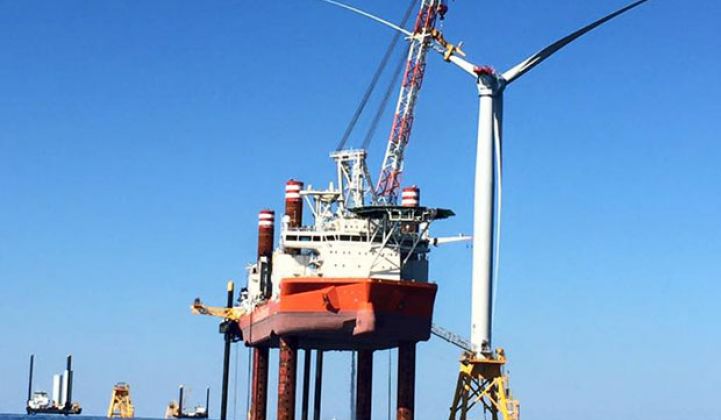Delaware is ready to rejoin the U.S. offshore wind race.
On August 28, Governor John Carney signed an executive order establishing an Offshore Wind Working Group. The working group is to submit a report to the governor by December 15 with “recommendations on short- and long-term strategies for developing wind power to serve Delaware, and plans to develop job opportunities in the offshore wind industry.”
The group was also tasked with drafting any necessary legislation, including possible amendments to Delaware’s Renewable Energy Portfolio Standards Act, which requires utilities to procure 25 percent of their load from renewable resources by 2025.
At the end of September, Gov. Carney announced appointments to the working group. The group is chaired by Bruce Burcat, head of the Mid-Atlantic Renewable Energy Coalition and former executive director of the Delaware Public Service Commission.
A renewed push for offshore wind in Delaware
This is not Delaware’s first foray into offshore wind. As far back as June 2008, Bluewater Wind Delaware, LLC signed a power-purchase agreement (PPA) with Delmarva Power to deliver electricity from an offshore wind farm as large as 600 megawatts in the Delaware lease area.
In an interview, Stephanie McClellan, director of the Special Initiative on Offshore Wind at the University of Delaware, noted that the Bluewater Wind PPA suffered from both bad timing (predating the Great Recession and the collapse of U.S. Department of Energy loan guarantee recipient Solyndra) and what proved to be unworkable assumptions about the availability of both federal tax credits and a DOE loan guarantee.
“The contract that was negotiated ultimately was not financeable, and all parties withdrew,” she said.
Fast-forward to December 2016 when Deepwater Wind, developer of Rhode Island’s Block Island Wind Farm, the United States’ sole commercial offshore project, asked the Bureau of Ocean Energy Management to transfer Bluewater Wind’s commercial lease to Garden State Offshore Energy, a Deepwater Wind subsidiary. BOEM approved the transfer on December 20, 2016. Officials in Delaware took notice.
“With Deepwater Wind obtaining that lease and the rights to develop offshore wind in that wind energy area, it brought back into focus for a lot of Delawareans -- including policymakers, activists and other stakeholders who were part of the initial offshore-wind push -- that there was an opportunity here to provide value to the state,” said McClellan.
What will the working group deliver?
What will the Offshore Wind Working Group recommend to Gov. Carney this fall? Possibilities include increasing Delaware’s RPS targets as well as a Massachusetts-style carve-out for offshore wind, according to industry-watchers contacted for this story.
“Some increase of the state’s RPS, possibly with a stronger offshore multiplier than they already have, or an outright offshore carve-out, is likely in the cards,” Anthony Logan, an analyst with MAKE Consulting, said in an email. MAKE Consulting is owned by Wood Mackenzie, Greentech Media’s parent company.
“An auction system would, given the progress seen in northern Europe, likely be an effective procurement mechanism in the long run," Logan continued. "An OREC [offshore wind renewable energy credits] design, much like Maryland’s, could remain attractive, as it would offer a way to leverage participation in the PJM marketplace. There’s not a lot of in-state load demand, certainly limited for the large generating capacities offshore wind projects bring on-line, so making the most of PJM is critical.”
A time to be bold
Moves by neighboring states to prime their economies for offshore wind, especially Maryland, appear to have spurred policymakers in Delaware to action. Gov. Carney’s executive order establishing the offshore wind working group even cites the Maryland Public Service Commission’s recent approval of ORECs supporting proposals from U.S. Wind and Deepwater Wind subsidiary Skipjack Offshore Energy, LLC to build offshore projects totaling 368 megawatts of capacity.
“These two projects, which are located off the Delaware coastline, will not make use of all the potential wind resource available in our offshore waters,” reads the order. “The Maryland projects could offer new opportunities to develop offshore wind at a scale and on a timetable that could create value at a reasonable balance of costs and benefits for Delaware.”
“The manufacturing facility in Maryland as part of the OREC solicitation has already given the Mid-Atlantic a head start,” noted MAKE's Logan. “With the right policies, Delaware has as good a shot as any at attracting the next facility. Any good governor is going to be asking, ‘How do I capitalize on this for my state?’”
Stephanie McClellan said she hopes the Offshore Wind Working Group will prompt policymakers and other stakeholders in Delaware to think bigger, and not just look at the benefits that would arise from one offshore project. She urged officials to kick off a regional conversation that could create a pipeline of projects and supply chain improvements across the Mid-Atlantic.
“If Delaware wants to see real economic benefits, now is not the time to be incremental," she said. "Now is the time to be bold.”
--
Come join us for GTM's first annual U.S. Power & Renewables Conference in November. You'll get an in-depth look at how the renewable energy market will interact with the U.S. power market, and how those interactions can impact overall industry development and market growth. Curated by GTM Research, MAKE, and Wood Mackenzie energy analysts, we’ll take an expansive view of key issues and timely topics, bringing together a diverse group of energy experts and stakeholders to discuss demand dynamics, economics and business model shifts, and policy and regulatory implications.



